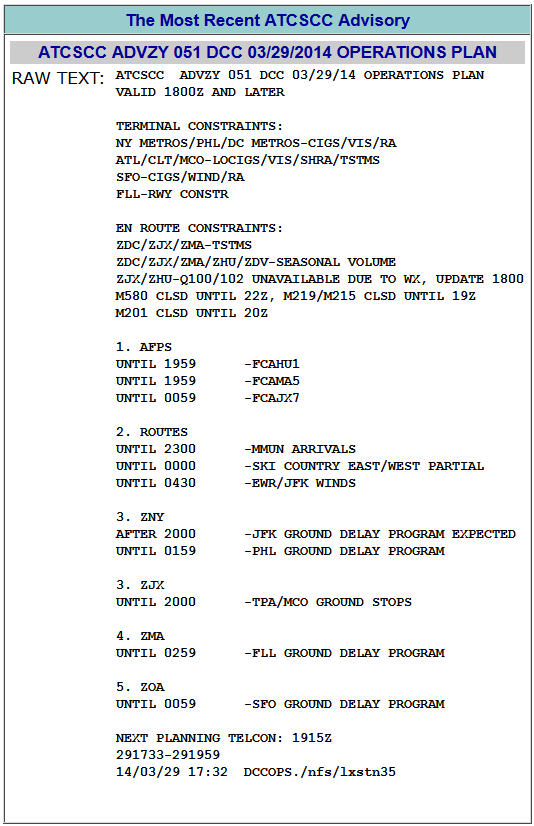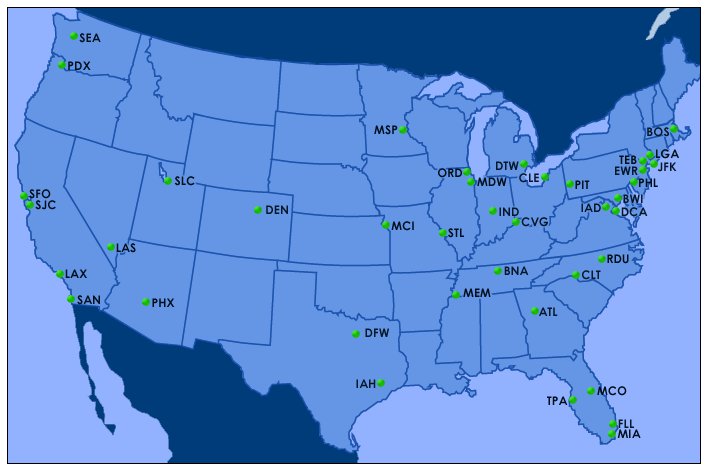
Advisories:
- An advisory message is disseminated electronically by the ATCSCC
- Advisories are sent when information, beneficial to a large number of people, is available
- Advisories may not be sent if the activity is only expected for a short length of time
- Advisories are normally issued for the following items:
- Ground Stops
- Ground Delay Programs
- Route Information
- Plan of Operations
- Facility Outages and Scheduled Facility Outages
- Volcanic Ash Activity Bulletins
- Special Traffic Management Programs (Computerized Voice Reservation System (e-CVRS)/e-STMP
Ground Stops:
- Ground stops are when aircraft are held on the ground and not permitted to takeoff
- Ground Stops are implemented for a number of reasons. The most common reasons are:
- To control air traffic volume to airports when the projected traffic demand is expected to exceed the airport's acceptance rate for a short period of time
- To temporarily stop traffic to allow time for the implementation of a longer-term solution, such as a Ground Delay Program
- The affected airport's acceptance rate has been reduced to zero
- The most widespread use of this procedure was on September 11, 2001
Ground Delay Programs:
- The Ground Delay Program (GDP) is a traffic management process administered by the ATCSCC; when aircraft are held on the ground
- The purpose of the program is to support the TM mission and limit airborne holding
- It is a flexible program and may be implemented in various forms depending upon the needs of the AT system
- Ground delay programs provide for equitable assignment of delays to all system users
Route Information:
- Route information is available on the web site and in specific advisories
- Some route information, subject to the 56-day publishing cycle, is located on the "OIS" under "Products," Route Management Tool (RMT), and "What's New" Playbook
- The RMT and Playbook contain routings for use by Air Traffic and NAS operators when they are coordinated "real-time" and are then published in an ATCSCC advisory
- The RMT and Playbook contain routings for use by Air Traffic and NAS operators when they are coordinated "real-time" and are then published in an ATCSCC advisory
- Route advisories are identified by the word "Route" in the header; the associated action is Required (RQD), Recommended (RMD), Planned (PLN), or For Your Information (FYI)
- Operators are expected to file flight plans consistent with the Route RQD advisories
Electronic System Impact Reports:
- Available at http://www.fly.faa.gov/ois/" under "System Impact Reports"
- This page lists scheduled outages/events/projects that significantly impact the NAS
- Information includes anticipated delays and Traffic Management Initiatives (TMI) that may be implemented
Conclusion:
- NAS operators are encouraged to access the website at http://www.fly.faa.gov prior to filing their flight plan
- This information is useful for pre-flight planning but remember, updates are published on a workload permitting basis
- Still looking for something? Continue searching:
References:
- Federal Aviation Administration - Pilot/Controller Glossary
- Aeronautical Information Manual (5-1-4) Operational Information System (OIS)
- Air Traffic Control System Command Center (ATCSCC)
- CFI Notebook.net - Navigation
- CFI Notebook.net - Flight Operations in Volcanic Ash
- Federal Aviation Administration Order (7400.9) Airspace Designations and Reporting Points
